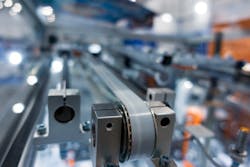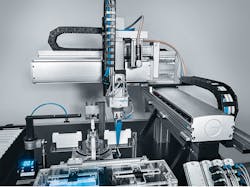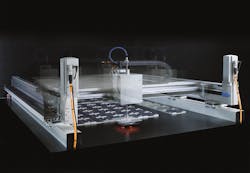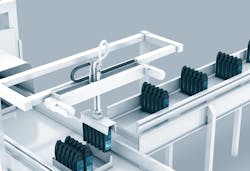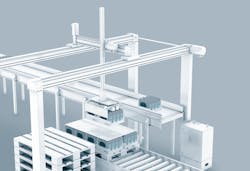How will linear motion affect machinery footprint?
A Control Design reader writes: Our custom packaging operation has flirted with the implementation of linear-motion technology to help reduce cycle times, but the cost and size always seem out of reach for us. I keep hearing that’s changing. Are there affordable choices for smaller applications, specifically for portals and palletizing? Throughput, precision and quality are important. Are there tradeoffs or limits to those gains in cycle times? Where else might we consider implementing linear motion? Are the linear components available with smart capabilities to help us with real-time performance optimization and predictive analytics? We’re also concerned about space, which is at a premium in our facility. Will linear-motion applications have any effect on the machinery footprint?
Answers
Get in line with the times
I’m thrilled that you inquired about linear systems because electric motion has come so far so fast not everyone knows the ins and outs.
A general definition of linear motion is an electromechanical actuator with a toothed belt or ball-screw drive train connected to a servo or stepper motor with an encoder. This electromechanical system is controlled by a drive and motion controller or programmable logic controller (PLC). Linear-motion control and Cartesian gantry systems are certainly more affordable because of economies of scale and advancing technology (Figure 1). These solutions offer a host of advantages.
If your application will benefit from increased dynamics, throughput, flexibility and fine motion control, then an electromechanical solution may be the optimum one. The most affordable electromechanical solutions use low-voltage steppers and servos paired with linear actuators.
System size depends on such factors as payload, acceleration, speed, torque, throughput and cycle rate. As these factors increase, the size increases and as they become lower, the size decreases (Figure 2).
Throughput can increase by moving to a toothed-belt mechanical actuator rather than a ball screw. Velocity and acceleration are significantly higher with a toothed-belt mechanism. There will be some loss of precision due to play in the system. Determining the tradeoff between throughput, velocity, acceleration, quality and precision in toothed-belt and ball-screw actuators are made clear during the specification phase of the project.
We advise customers to thoroughly understand the key application considerations of force, load, speed, acceleration, throughput, longevity and cycle times and then size appropriately.
Beyond palletizing and portal applications, some of the major areas to use linear motion include 90° conveyor transfer, extending nose conveyors, case erecting, major and minor flap closing, overpressure for gluing, picking and placing in top or side load case applications and stretch wrapping (Figure 3).
Interestingly, companies like to apply six-axis robots because of the robot’s flexibility. If the application has the need for only three or four axes of motion, a Cartesian robot can be the better option. It’s just as flexible within those axes, is less expensive and offers a more compact work envelope. And a Cartesian robot is 100% accurate within the work envelope, where the six-axis and Delta robots lose accuracy on the periphery (Figure 4).
Most linear systems use high-resolution encoders on servo motors, which incorporate capabilities such as position feedback and torque control. Fault and alarm data can be sent to an edge device and analyzed from the cloud for improved process efficiency. Similarly servo drives, which offer accessible parameters and process data, allow the end user to monitor the average speed and cycle rates of defined motion profiles. Out-of-specification profiles show pending problems.
Accessories can be used with linear systems to lower the risk of unplanned shutdowns. For example, linear encoders can indicate when precision and repeatability are trending beyond normal limits. Vibration sensors can pinpoint problems before they become critical, such as a flat facing recirculating ball bearing.
Linear motion has a more compact footprint than a robot, which has a large swing radius and requires guarding. Linear gantries easily maximize the pick locations within a rectangular workspace, making them ideal for working over conveyors that move in cardinal directions (Figure 5).
Andy Lewis
electric automation business driver, food and packaging North America / Festo
Match performance and cost parameters
Linear-motion suppliers typically offer several performance and price options to suit the customer’s criteria and match the application requirements. The criteria or needs of the application typically coincide with the relative cost of the linear-motion solution. To optimize performance and value, linear-motion providers need to best understand the customer’s needs to arrive at an appropriate solution.
Typical questions the user must consider to match performance and cost parameters of the project would include the following lists.
For precision:
• What is more important, accuracy or repeatability?
• What is the accuracy/repeatability requirement?
• Are these values realistic, based upon the desired motion profile?
For orientation:
• How will the system be mounted—normal, on its side, inverted, vertical, at an angle?
• How will this affect the load requirements?
For speed:
• What is the maximum speed and acceleration required?
• What is the maximum jerk allowable?
• What motion profile, or shape, is desired?
For travel:
• What is the required travel, or stroke?
• What is the overall envelope allowed?
• How much over-travel—safety zone—is required?
For loading:
• What is end-of-arm tooling (EOAT), and where is it located?
• What additional forces are seen by the system during use—for example, cutting or pushing forces?
• What do the static and dynamic free body diagrams look like? Have all loads been accounted for?
For duty cycle/life cycle:
• What is the actual duty cycle for the system?
• What is the expected lifetime?
For environmental considerations:
• In what environment will the system be installed?
• Are there any hazards in the environment?
• What is the maintenance schedule, and is the system accessible for maintenance/lubrication?
• Are there contaminants in the environment that can damage the motion system?
• Will the system disburse contaminants into the environment that could damage other equipment or products?
For unknowns:
• What are the known unknowns? What is a reasonable value for these unknowns?
• How will someone misuse this system?
• What could possibly go wrong?
• What else could go wrong? Repeat this question until you can’t think of anything else.
For safety:
• Are there any safety standards to which this system needs to conform?
• What could happen if the system fails?
• Are there safeguards that need to be installed for a system failure?
• Could people be injured by this system? If so, how will the system be protected?
Dave Walden
applications engineer / PBC Linear
Spacing-saving linear motion
The ability to provide fast, accurate linear motion control for front and end-of-line applications continues to expand. Linear devices can provide greater capacities for heavy loads, but there are also low-profile mini systems for smaller load applications. Typically, low-profile linear systems allow for use in small spaces, operate with loads under 20 lb and can be used economically.
Perhaps at first there can be tradeoffs to gains in cycle times, but with advances in magnet technology and screw actuator sizes, there really are no limits. Direct drive systems tend to operate extremely efficiently. They do not require fluids and are therefore cleaner. They are smaller and require less assembly time. The greatest advantage is in the throughput, precision and quality. Linear systems allow for multiple point positioning via programming changes, they can quickly reverse and turn the product around. They are extremely accurate in their positioning.
Typically, you have a much smaller footprint, but linear motion is also well-suited for retrofitting existing equipment. Things to consider are the typical design questions: load, uptime, ambient operating or communication requirements. It is always best to look at the existing system and determine where it is failing and how it needs to be improved.
Absolutely, components are available with smart capabilities; this is one of their strengths. A linear-motion system consists of four main categories: actuators, linear bearings, motors and control. There are many actuators on the market with intelligent communication capabilities. Linear bearings are maintenance-free. Linear motors are direct drive and are available with smart communication. The controls provide constant feedback with the system and enable machine intelligence and communication beyond the machine.
Again, machinery footprint is where linear motion shines. Think of the traditional approach of driving conveyors with gearboxes and racks, bearings, ball screws, pinions, belts, chains, large motors, large ac drives. Not only is the footprint for the traditional setup larger, it also requires considerable maintenance. Think of a three-shift operation, seven days a week. The machinery needs lubrication. It is messy. The machinery has a high electrical demand. In every instance, linear motion is more efficient. The space savings alone can be 50%.
Perry Hudson
market manager, packaging / Pepperl+Fuchs
Repetitive precision and better control
Multiple solutions can be used for portals or palletizing. For portals, some electric actuators can be used and are built in a way where the motor is in parallel, which makes the solution more compact. These solutions are produced for many different applications, which helps reduce their costs as more industries are moving to linear motion, increasing the availability of cost-effective products. They also have the ability of integrating feedback options to help monitoring. All of this, with the benefit of no maintenance, results in less downtime and increased productivity.
For palletizing, a trend we are seeing is the use of collaborative robots together with a vertical lifting solution. These solutions increase process speed and can run continuously resulting in increased productivity; they also help operators, reducing strain and health concerns due to repetitive lifting of the boxes. These linear-motion solutions offer both precision and repetitiveness, allowing for better control of the movement and optimizing the cycle times.
In general, linear-motion solutions can be implemented wherever there is a push/pull or lift movement. Some actuators have now built in monitoring, and they collect data on force, speed, position feedback and temperature and send it to a controller to be analyzed. All these parameters can give crucial information on how the actuator is behaving, can detect if there is an anomaly—peak force detection—and report it to the PLC or controller. This can help define predictive maintenance more accurately and reduce downtime.
When it comes to concerns about space, the same product can be used for multiple applications. Multiple programs can be written in advance for the different products that might pass on the same line. This can help optimize line usage and can be used for multiple purposes, without having to duplicate lines, therefore reducing machinery footprint.
Grégor Caillon
sales engineer / Ewellix USA, distributor for RS
Your application determines throughput
We have a wide range that customers can pick from. Thinking about portals and palletizing robot solutions might come to mind right away, however, might not always fit the budget. Another smart flexible manufacturing solution for this application is based on linear-motor technology that increases throughput and reduces total cost of ownership. It provides a faster, cleaner and more efficient and productive alternative to pallet conveyor systems. Lastly, if you are looking for an even smaller budget a linear motor and gantry portfolio would be another alternative.
Throughput is determined by your application, but there are various examples that more than doubled the throughput compared with traditional conveyance with a decreased footprint by sometimes half the size. And, lastly, supporting your sustainability targets as you are just consuming energy where your magnet array is positioned, linear motors are naturally the choice for energy efficiency.
The sky is the limit for implementing linear motion. Constantly, we see new applications using this technology, which weren’t thought of before. Warehousing, ecommerce, logistics, life sciences, consumer packaged goods, automotive, electrical vehicle battery, semiconductor—limitations are only your own creativity. Built-in motor analytics combined with digital-engineering tools help not only to easily identify and point out where the issue or jam is in the sometimes km-long line, depending on the application, but also help to predict failures before they happen, as well as provide insights into how to further optimize your manufacturing line. Digital engineering, analytics and our devices/components go hand in hand to provide further value not only from maintenance view, but already starting at the machine design—creating your own digital twin of the line, predicting the throughput and allowing simulation with bi-directional integration of the engineering environment using object-oriented programming for further simplification and standardization.
Using linear motor technology requires you to re-think your traditional design. You benefit most, if you truly understand the value and how it can improve your current design.
Michaela Kaufmann
business manager / Rockwell Automation
3 common types of actuators
When looking to implement linear motion there are three common types of actuators that will give you linear motion. Ball-screw and belt actuators convert rotary motion to linear motion, while linear motors are motors that move linear inherently.
Converting rotary motion to linear motion is the most cost-effective way of getting linear motion, but you do have a tradeoff for speed, accuracy and force.
Ball-screw actuators are a very good form of linear motion actuators that give very good mechanical advantage when converting rotary to linear motion. By selecting the best pitch screw for the application, you can maintain good speeds, while having good force for the acceleration and deceleration of the load.
Belt actuators allow for higher speeds than ball screws and give good positional accuracy. High acceleration and deceleration are achievable with good force. There are slight inaccuracies mechanically that should be looked at if very high accuracies are needed.
Linear motors have the highest level of capabilities. They have the ability to achieve the highest velocity, acceleration/deceleration and accuracy. They also come with a higher price tag than the other two options.
While all three of these solutions do take up some space, linear motors can have the advantage of being implemented into the machine itself. A linear motor has many components, but the main two are the magnet track and the coil that will travel along that track. Some manufacturers will supply these two items and allow the machine builder to build them into the machine framing to save space. This does take some planning to align the magnet track and coil along the linear rails that the machine builder chooses.
Greg Dieck
product manager, motion / Omron Automation
About the Author
Anna Townshend
Managing Editor
Anna Townshend has been a writer and journalist for 20 years. Previously, she was the editor of Marina Dock Age and International Dredging Review, until she joined Endeavor Business Media in June 2020. She is the managing editor of Control Design and Plant Services.

Leaders relevant to this article:
